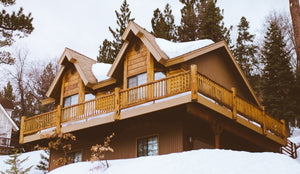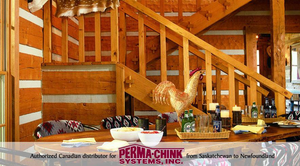
ENVIRONMENTAL ISSUES
Most oil-based finishes contain some type of organic solvents that evaporate into the air when they dry. These components are known as Volatile Organic Compounds (VOCs). When VOCs are in the vapor state and interact with NOx (Nitrogen Oxides) in the presence of ultraviolet (UV) light, ground level ozone or smog, a health hazard to humans, forms.
Some oil-based products are promoted as being “green” since they are made from renewable plant oils like linseed or soybean oil but even these products require mineral spirits or turpentine (high VOC, disposal regulated products) for clean-up. Although Lifeline water-based finishes also contain some VOCs, they are at a much lower level than oil-based products and clean-up requires only soap and water. That’s why environmental organizations promote the use of water-based products whenever possible.

PREPARATION
One of the requirements of oil-based finish systems is that the wood must contain less than 18% moisture content before they are applied. Everyone knows that oil and water do not mix. A film of oil will repel any water and water vapor that’s contained in the wood, as well as what hits the surface. On the other hand, if even a minor amount of water is present on the surface of the wood during the application of an oil-based stain, the coverage, adhesion, and penetration of the oil will be compromised with a resulting decrease in durability and performance. This prevents the use of oil-based products on even slightly moist logs or green wood. Recommendations typically include waiting at least three days after stripping or cleaning walls before applying the first coat of any oil-based product.
Lifeline is a film-former that behaves like a semi-permeable membrane allowing water vapor to escape from the wood but preventing liquid water from penetrating into it. That is why Lifeline can be applied to logs containing 30 to 35% moisture content. In addition, Lifeline may be applied the day after cleaning, as long as the wood cells at the surface are not filled with water.

APPLICATION RATES
Most oil-based finishes require heavy applications, especially for the first coat on bare wood. Recommended application rates ranging from 75 to 150 square feet per gallon are not unusual. This translates into a lot of oil-based product required to stain a home.
Let’s look at 2400sqft of wood surface that needs staining. If we assume an average coverage rate of 100sqft/gallon, it means that it will take 24 gallons of an oil finish to apply one coat. If two coats are necessary it may take an additional 12 or more gallons to finish the job for a total of 36 gallons. That’s a lot of product.
Lifeline stains have a much higher coverage rate than oil-based products since they do not soak or penetrate into the wood, are specifically designed with low viscosities to maximize the coverage rates, and are easy to apply using airless sprayers. Other than Lifeline, very few stains that we’ve seen and evaluated- including other water-based products- have an initial coverage rate of 350 to 450sqft/gallon on bare wood.
When we compare the amount of Lifeline required to cover 2400sqft to the oil-based example, we end up with 6 gallons for the first coat and 4 gallons for the second coat for a total of 10 gallons of Lifeline stain, verses 36 gallons of the oil-based product.
PRODUCT APPLICATION
Without a doubt, some oil-based penetrating stains are easy to apply. Some even recommend the use of garden sprayers with no mention of back-brushing. On the other hand, multi-coat oil-based products can present a challenge to the applicator. Virtually all multi-coat oil-based stains require at least 24 hours between coats. Another problem with oil-based finishes is their drying time. Most stay tacky for a week or so after application. If a multi-coat product is used, it is difficult to avoid ladder marks while applying the second or third coats. Of course dirt, dust, leaves, bugs and other flying debris tend to stick to the finish until it finally dries.
Lifeline finishes do require some knowledge to be applied correctly. They are a bit more susceptible to runs, drips and lap marks than oil-based products, but that is why we try to provide product training especially to homeowners through our literature and seminars. To professionals, Lifeline offers some distinct advantages such as being compatible with most airless sprayers and fast drying times which allows multiple coats to be applied the same day.
CLEAN-UP
The only effective way to clean oil-based products from hands and equipment is with turpentine or mineral spirits. Although the labels of some oil-based products claim soap and water clean-up, we have yet to see one that does not make a mess when these directions are followed. The disposal of used turpentine and mineral spirits in a responsible way is a real challenge to both homeowners and contractors.
Water-based products like Lifeline are easily cleaned up with soap and water. The effluent from washing hands and equipment presents no environmental issues and application equipment like sprayers and brushes can be easily and thoroughly cleaned in preparation for the next job.
PERFORMANCE
On sun exposed walls, the life expectancy of even the best one- or two-coat penetrating oil-based stain is two to three years- at most. Since they are made to penetrate into the wood, they leave very little protection on the surface where it is needed most. Multi-coat, film-forming oil-based products exhibit better performance than the penetrating products, but the new VOC requirements have had a detrimental impact on them. They are not the same products they were five or seven years ago.
For those products that contain extracted plant oils like linseed, tung, or soybean oil, mold growth is a real concern. Although they may claim to contain mildewcides, the level of mildewcides is rarely enough to overcome the susceptibility of these organic oils to biological growth.
Another characteristic of film-forming oil-based finishes is that they darken with age. This is due to the oxidation of the oil components contained in the stain. As previously stated, film-forming oil-based products do not allow water vapor to escape from the wood. They are not breathable. If water does enter the logs through fissures and checks, there is a good chance that the finish will begin to peel off as water vapor builds up pressure under the finish.
Performance is where our Lifeline products differentiate themselves from oil-based and other water-based stains. There is no question that some water-based products perform no better than the poorest quality oil-based stains. But our Lifeline systems are designed for performance, and we have yet to discover another transparent stain system with the equivalent performance of Lifeline finishes with our Advance Topcoat.
When we talk about performance what exactly do we mean? From a technical perspective, we discuss terms like vapor permeability, adhesion, UV resistance, etc. But to a homeowner, performance comes down to how long will it be before the finish looks so bad that it has to be reapplied. We all know that it is impossible to give a definitive answer to this question since so much depends on environmental factors. But we can say that in side by side comparisons, our Lifeline systems have lasted longer than all of the competitive products that we have tested.
LIFELINE STAINS VERSUS OIL-BASED STAINS
LIFELINE FINISHES
- Low VOC, low environmental impact. Considered the product of choice by environmental organizations.
- For best results, we recommended moisture contents of 20% or less.
- Can be applied the day after cleaning as long as surface is dry to the touch.
- High coverage rates. Low viscosity allows application of thin coats.
- Fast drying. Wait 2 to 4 hours between coats. Topcoat provides a hard protective surface within hours.
- Clean-up with soap and water.
- Ultra-2 or Ultra-7 and Advance are warranted for three to five years.
- Advance topcoat helps retain color for years.
- Advance adds addition water repellency and UV protection to the finish system.
OIL-BASED FINISHES
- Not friendly to the environment.
- Wood must contain less than 20% moisture content.
- Must wait at least three days after cleaning.
- Low coverage rates, takes much more product to stain a home.
- Slow drying. Wait at least 24 hours between coats. May stay tacky for weeks.
- Clean-up requires turpentine or mineral spirits.
- One coat products last one to two years.
- Film forming products darken with age, especially around knots.





Leave a comment